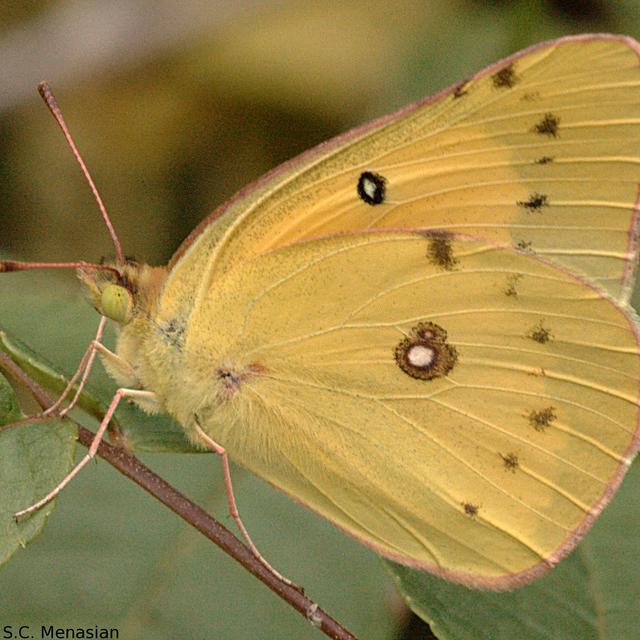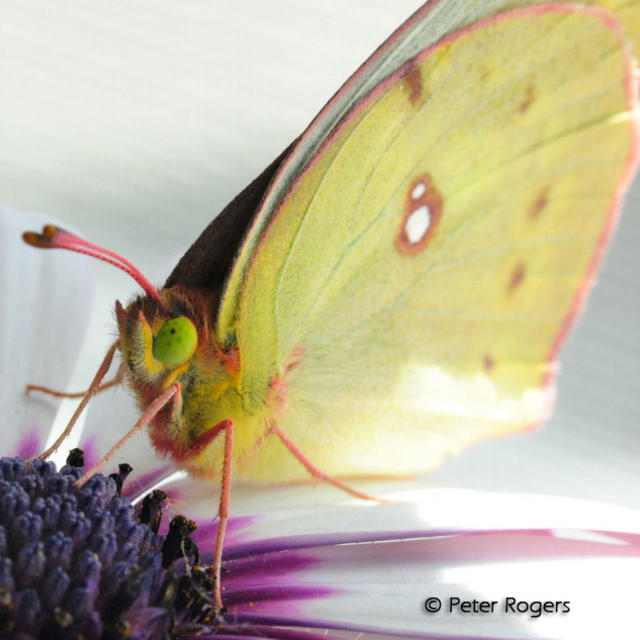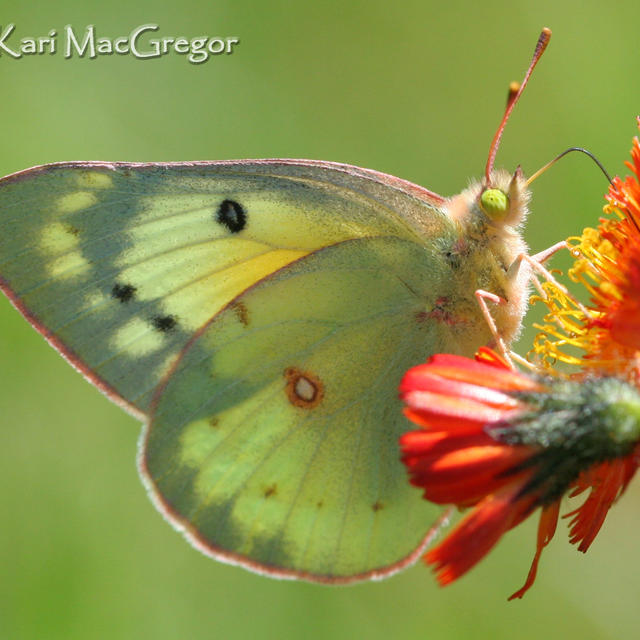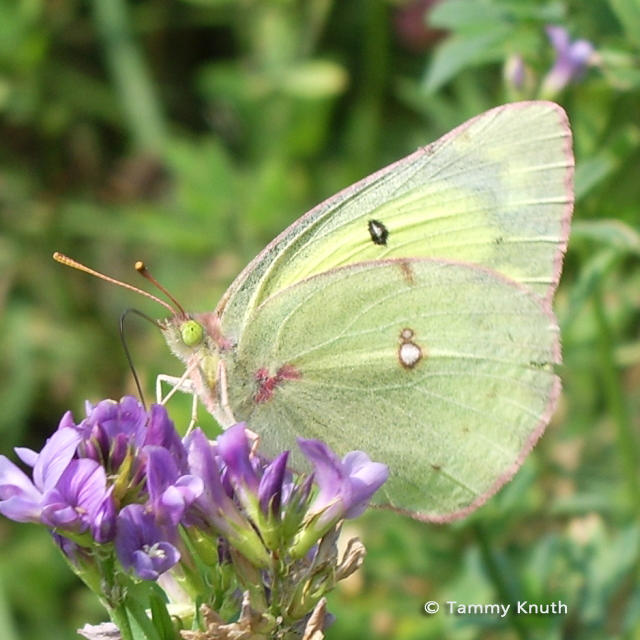Orange Sulphur
Colias eurytheme Boisduval, 1852
Family: Pieridae
Subfamily: Coliadinae
Identification: Quite variable. Upperside of male yellow with orange overlay, yellow veins, wide black border, and dark black cell spot. Female yellow or white with irregular black border surrounding light spots. Underside hindwing spot silver with 2 concentric dark rings, and a spot above it.
Wing Span: 1 3/8 - 2 3/4 inches (3.5 - 7 cm).
Life History: Males patrol for receptive females, who lay eggs singly on top of host plant leaves. Most feeding takes place at night. Young caterpillars chew holes in the tops of leaves, then later feed from the leaf tip. Older caterpillars eat half of the leaf before moving to the other half. Chrysalids overwinter.
Flight: Two-three flights in the north from June-October, 4-5 in the south from March-November.
Caterpillar Hosts: Plants in the pea family (Fabaceae) including alfalfa (Medicago sativa), white clover (Trifolium repens), and white sweet clover (Melilotus alba).
Adult Food: Nectar from many kinds of flowers including dandelion, milkweeds, goldenrods, and asters.
Habitat: A wide variety of open sites, especially clover and alfalfa fields, mowed fields, vacant lots, meadows, road edges.
Range: Southern Canada to central Mexico, coast to coast in the United States except for the Florida peninsula. Comments: One of the most widespread and common butterflies in North America.
Conservation: Not required.
NCGR: G5 - Demonstrably secure globally, though it may be quite rare in parts of its range, especially at the periphery.
Management Needs: Caterpillars can be very destructive in alfalfa fields.
Get your BAMONA Gear!
Please donate!
We depend on donations to keep Butterflies and Moths of North America freely available. We want to express our gratitude to all who showed their support by making a contribution this year. You can donate to support this project at any time.
Advertise with us!
Do you have a product or service that you think would interest BAMONA users? If you would like to advertise on this website, contact us by email, or use the contact form and select the "Advertising" category.
Verified Sightings
Displaying 145 - 168 of 12809 verified sightings

Observation date: Jul 05, 2023
Submitted by: bonfrey
Region: Colfax County, New Mexico, United States
Verified by: stevecary
Verified date: Aug 19, 2023

Observation date: Aug 07, 2023
Submitted by: Robert Gorman
Region: Mono County, California, United States
Verified by: Ken Davenport
Verified date: Aug 18, 2023

Observation date: Aug 07, 2023
Submitted by: MAKI
Region: Santa Barbara County, California, United States
Verified by: Ken Davenport
Verified date: Aug 17, 2023
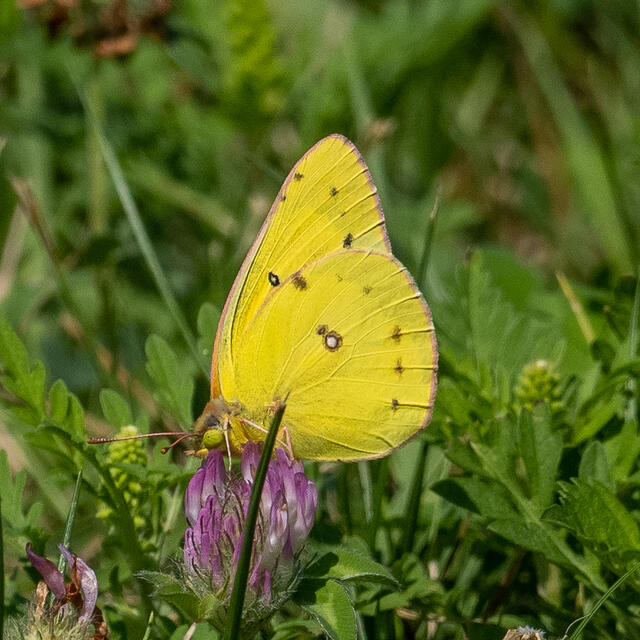
Observation date: Aug 25, 2021
Submitted by: cp2023
Region: New Haven County, Connecticut, United States
Verified by: jwileyrains
Verified date: Aug 15, 2023

Observation date: Oct 20, 2021
Submitted by: tirvine2020
Region: Bristol County, Rhode Island, United States
Verified by: Harry Pavulaan
Verified date: Aug 14, 2023

Observation date: Aug 12, 2023
Submitted by: erinlale
Region: Clark County, Nevada, United States
Verified by: Ken Davenport
Verified date: Aug 13, 2023

Observation date: Aug 05, 2023
Submitted by: Sue Bocchicchio
Region: Centre County, Pennsylvania, United States
Verified by: davidwright
Verified date: Aug 06, 2023

Observation date: Apr 30, 2023
Submitted by: billd
Region: Garfield County, Oklahoma, United States
Verified by: CA Ivy
Verified date: Aug 04, 2023

Observation date: Jul 28, 2023
Submitted by: MAKI
Region: Ventura County, California, United States
Verified by: Ken Davenport
Verified date: Aug 04, 2023

Observation date: Jul 26, 2023
Submitted by: ezeemonee
Region: Kern County, California, United States
Verified by: Ken Davenport
Verified date: Aug 04, 2023

Observation date: Jul 30, 2023
Submitted by: camflies
Region: Kern County, California, United States
Verified by: Ken Davenport
Verified date: Aug 03, 2023

Observation date: Jul 24, 2023
Submitted by: madamirie
Region: Tehama County, California, United States
Verified by: Ken Davenport
Verified date: Aug 03, 2023

Observation date: Jul 08, 2023
Submitted by: robtluke@aol.com
Region: Bernalillo County, New Mexico, United States
Verified by: stevecary
Verified date: Jul 27, 2023

Observation date: Apr 17, 2023
Submitted by: Keith Barnes
Region: Burnet County, Texas, United States
Verified by: jwileyrains
Verified date: Jul 25, 2023

Observation date: Jul 21, 2023
Submitted by: jwileyrains
Region: Litchfield County, Connecticut, United States
Verified by: jwileyrains
Verified date: Jul 25, 2023

Observation date: Jun 21, 2017
Submitted by: Puccini
Region: Roberts County, South Dakota, United States
Verified by: J_Martineau
Verified date: Jul 25, 2023

Observation date: Jul 23, 2023
Submitted by: DeepSkyKelly
Region: Colfax County, New Mexico, United States
Verified by: stevecary
Verified date: Jul 24, 2023

Observation date: May 06, 2023
Submitted by: COA1955
Region: Morgan County, Colorado, United States
Verified by: mikefisher
Verified date: Jul 24, 2023

Observation date: Jul 12, 2023
Submitted by: DeepSkyKelly
Region: Union County, New Mexico, United States
Verified by: stevecary
Verified date: Jul 21, 2023

Observation date: Jul 17, 2023
Submitted by: vogelbild
Region: DuPage County, Illinois, United States
Verified by: rogerdowner
Verified date: Jul 19, 2023

Observation date: Jul 11, 2023
Submitted by: bekkfree
Region: Cowley County, Kansas, United States
Verified by: James Steen
Verified date: Jul 16, 2023

Observation date: Aug 16, 2020
Submitted by: neilpa
Region: Oscoda County, Michigan, United States
Verified by: elsner
Verified date: Jul 16, 2023

Observation date: Jul 13, 2023
Submitted by: heather-russell
Region: Wake County, North Carolina, United States
Verified by: Dennis Forsythe
Verified date: Jul 16, 2023

Observation date: Jul 03, 2023
Submitted by: seemayer
Region: Sedgwick County, Kansas, United States
Verified by: James Steen
Verified date: Jul 08, 2023
- ‹ previous
- 7 of 534
- next ›







